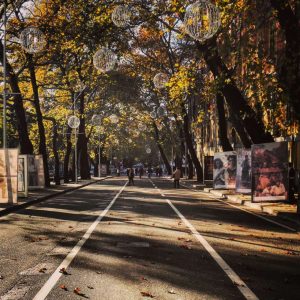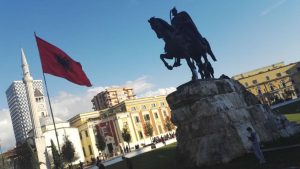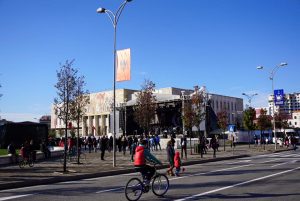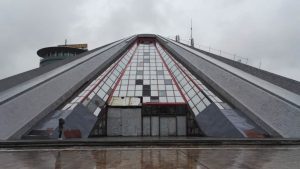With one of the most fascinating histories in Europe combined with an incredibly diverse landscape, it is no wonder that tourism to Albania has increased by almost 1000 percent in the last ten years. This increase, however, has come almost exclusively from Balkan and Eastern European countries, with English speaking tourists constituting only a very small proportion of overall travellers.
We packed into a tiny bus in Pristina and made our way through the beautiful mountains of Kosovo to the Albanian border . The date was November 27th and, this being one day before Albanian Independence Day, we were met with a sea of red and black flags carrying the imposing Albanian symbol of the double-headed eagle. Arriving in Tirana at around 7pm and after unloading our bags at the wonderful Freddy’s Hostel, we went out to Tirana to sample the local nightlife. Being a Friday night, the bars around Blloku were well-filled and so we, of course, joined the locals by drinking beers and rakia in one of the many bars in the area – Interestingly, the area of Blloku once contained the home of former ruler of Albania, Enver Hoxha, and previously, admittance was only granted to those in the highest of government positions. Not so anymore and so, after bar hopping around the area, we found a taxi driver and after asking him to take us to one of the famous Tirana clubs he pulled up outside Venue, allowing us to stumble into the cavernous warehouse filled with great cocktails, progressive beats and Tirana’s most glamorous. Upon being told by bouncers to not walk around the club so much and to not talk to certain people, we quickly realized that clubbing in Albania is a tad different than other places. Eventually, we talked to the wrong people one too many times and were escorted out of the club at a time of which I couldn’t even hazard to guess.
. The date was November 27th and, this being one day before Albanian Independence Day, we were met with a sea of red and black flags carrying the imposing Albanian symbol of the double-headed eagle. Arriving in Tirana at around 7pm and after unloading our bags at the wonderful Freddy’s Hostel, we went out to Tirana to sample the local nightlife. Being a Friday night, the bars around Blloku were well-filled and so we, of course, joined the locals by drinking beers and rakia in one of the many bars in the area – Interestingly, the area of Blloku once contained the home of former ruler of Albania, Enver Hoxha, and previously, admittance was only granted to those in the highest of government positions. Not so anymore and so, after bar hopping around the area, we found a taxi driver and after asking him to take us to one of the famous Tirana clubs he pulled up outside Venue, allowing us to stumble into the cavernous warehouse filled with great cocktails, progressive beats and Tirana’s most glamorous. Upon being told by bouncers to not walk around the club so much and to not talk to certain people, we quickly realized that clubbing in Albania is a tad different than other places. Eventually, we talked to the wrong people one too many times and were escorted out of the club at a time of which I couldn’t even hazard to guess.
We were met with a sea of red and black flags carrying the imposing Albanian symbol of the double-headed eagle.
 The following day, November 28th, marked Albanian Independence Day, the day on which the locals celebrate the end of Ottoman rule of their country and the declaration of an independent Albanian nation. The Ottoman Empire began occupying Albania around 1415 and continued its rule until 1912. During this period, the Islamization of Albania occurred and the result of this can still be seen today through the 59% who adhere to the Islamic faith. The period of Ottoman rule also played host to the rise of Albanian legend Skanderbeg – the figure and name that graces Tirana’s main square – who, to the surprise of many western powers at the time, successfully defeated the powerful Ottoman forces in many battles.
The following day, November 28th, marked Albanian Independence Day, the day on which the locals celebrate the end of Ottoman rule of their country and the declaration of an independent Albanian nation. The Ottoman Empire began occupying Albania around 1415 and continued its rule until 1912. During this period, the Islamization of Albania occurred and the result of this can still be seen today through the 59% who adhere to the Islamic faith. The period of Ottoman rule also played host to the rise of Albanian legend Skanderbeg – the figure and name that graces Tirana’s main square – who, to the surprise of many western powers at the time, successfully defeated the powerful Ottoman forces in many battles.
Feeling a little worse for wear from the previous night’s activities we had a leisurely day and took in a city tour that started at 10am from the National History Museum. As with any of these tours, objectively learning about the culture and history is of course interesting, but it is hearing the guide’s viewpoint and listening to personal memories that provide the real draw. This tour was no different and it was fascinating to hear how the country of Albania has changed from the 1990’s, when they decided to normalize international relations, to today. The guide explained to  us that as late as the 1980’s, an Albanian national could not travel outside the country unless for work purposes, could not grow a beard, was not allowed to view anything western influenced and was often subjected to draconian police interrogations based on little or no evidence. The Sigurimi (Albania’s equivalent of the KGB) employed tough tactics on its civilians and the guide relayed to us that at one point, every third Albanian had at some point been incarcerated in the labour camps or been interrogated at some point. Following the tour we paid a visit to the Art Museum which holds a wide variety of different styles of art from different periods of history. With most of us having been in North Korea and thus been exposed to the propaganda art of that country, we were most interested in the Socialist Realism section and headed straight for that. It did not disappoint and much like its DPRK counterpart, it sought to demonstrate not only nationalistic military might, but also its advancements in industry and agriculture.
us that as late as the 1980’s, an Albanian national could not travel outside the country unless for work purposes, could not grow a beard, was not allowed to view anything western influenced and was often subjected to draconian police interrogations based on little or no evidence. The Sigurimi (Albania’s equivalent of the KGB) employed tough tactics on its civilians and the guide relayed to us that at one point, every third Albanian had at some point been incarcerated in the labour camps or been interrogated at some point. Following the tour we paid a visit to the Art Museum which holds a wide variety of different styles of art from different periods of history. With most of us having been in North Korea and thus been exposed to the propaganda art of that country, we were most interested in the Socialist Realism section and headed straight for that. It did not disappoint and much like its DPRK counterpart, it sought to demonstrate not only nationalistic military might, but also its advancements in industry and agriculture.
As late as the 1980’s, an Albanian national could not travel outside the country unless for work purposes, could not grow a beard and was not allowed to view anything western influenced.
It being Albanian Independence Day and us being the cultural souls that we are, we headed to Meduza’s Irish Pub to drink away the evening with the Tirana locals.
Surely one of the only countries to have its two biggest holidays side by side, the following day, November 29th, marked Albania’s Liberation Day. Owing to both its post war isolationist stance and its peripheral location in Europe, the country is often overlooked as a victim of World War 2 but with the Centre for Relief to Civilian Populations calling it one of the most affected countries in Europe, it is clear that the occupation by Italy and then Germany caused immense devastation.
On Liberation Day we took a short walk down to Skenderbeg Square and reveled in the atmosphere as traditional music played and troupes performed cultural dances. The local beer, costing less than one euro, also added to the excitement of the day and we basked in the unseasonable warmth as we sipped on our ice cold pints, absorbing all the Albanian culture around us. Deciding to go explore a little, we took a walk up to the Pyramid, a building designed by Hoxha’s daughter. Although very architecturally significant, it is also clearly the place that health and safety rules forgot, as dozens of people walked and ran up and down the sides of various gradients. We of course had a go too but the height and general precariousness of the activity was a little too much for some in the group.
 The Pyramid was built in the aftermath of Hoxha’s death and was originally used as a museum for him. The use however changed as the years passed and Hoxha’s legacies began to disappear from society. Overall, the period of Hoxha’s rule, from 1944 to 1985 is now viewed by the vast majority as a dark time in Albania’s history. As with any ex-socialist country, there will always be those who think back on ‘the good old days’ and are nostalgic for the way things used to be (or rather, the way they perceive them to have been) but these people are very much in the minority. Hoxha worshipped Stalin and when Stalin died in 1953, he assembled all Albanian people at the main square in Tirana, asked them to get on their knees, and made them take a two thousand word oath of eternal fidelity to their beloved father to whom they owed “everything.” Incidences such as this combined with the implementation of policies that made it the poorest country in Europe, and an inability to emigrate, resulted in a quick dissipation of Hoxha’s legacy.
The Pyramid was built in the aftermath of Hoxha’s death and was originally used as a museum for him. The use however changed as the years passed and Hoxha’s legacies began to disappear from society. Overall, the period of Hoxha’s rule, from 1944 to 1985 is now viewed by the vast majority as a dark time in Albania’s history. As with any ex-socialist country, there will always be those who think back on ‘the good old days’ and are nostalgic for the way things used to be (or rather, the way they perceive them to have been) but these people are very much in the minority. Hoxha worshipped Stalin and when Stalin died in 1953, he assembled all Albanian people at the main square in Tirana, asked them to get on their knees, and made them take a two thousand word oath of eternal fidelity to their beloved father to whom they owed “everything.” Incidences such as this combined with the implementation of policies that made it the poorest country in Europe, and an inability to emigrate, resulted in a quick dissipation of Hoxha’s legacy.
Following the Pyramid, we made our way back to Freddy’s and prepared for our trip up to the beautiful coastline of Montenegro. Due to the Kosovo situation, a simmering animosity exists between Albania and the countries of Serbia and Montenegro – a situation which became all too clear through my local friend’s exasperation as he ran after the the group to warn us not to wear the red and black Albanian shirts at any point across the border. He explained to us that if the wrong person sees that we are even carrying products emblazoned with the double headed eagle, it will cause some trouble. On the 28th, we celebrated Albania’s independence from the Ottomans, on the 29th, we celebrated their liberation from the Nazis. On the 30th, the irony was not lost on us that despite celebrating two different days of freedom in the previous two days, the Albanians, due to the situation in the Balkans, are a long way from any real peace.





